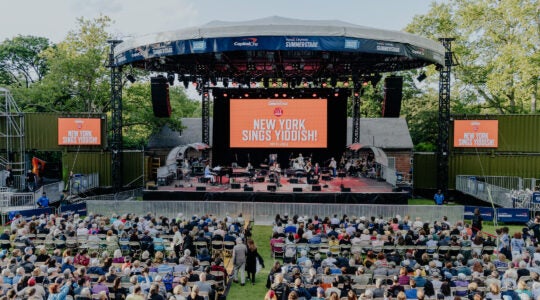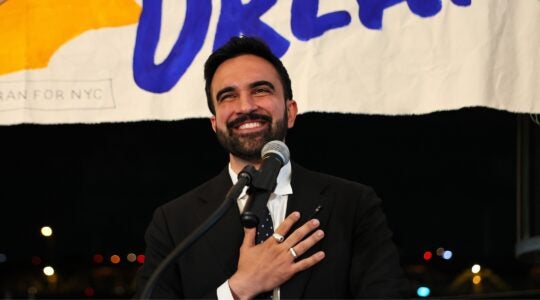Fearing that within the next 20 years Israeli Arabs will outnumber Israeli Jews in the Galilee and the Negev, the board of the United Jewish Communities will be asked to approve a $200 million emergency program over five years to settle 300,000 Jews in both regions in the next decade.
The board is slated to consider the request at its meetings in November in Israel. The $200 million is part of the $1.25 billion the project is expected to cost. Among the other contributors are the government of Israel, the Jewish National Fund, the Federation of Jewish Organizations of Russia, and the International Fellowship of Christians and Jews, according to Shai Hermesh, treasurer of the Jewish Agency.
He stressed that the $200 million the Jewish Agency is asking from the UJC over five years is on top of the $140 million to $150 million the UJC currently allocates annually to the Jewish Agency.
"We expect that the UJC will find a way to raise more money for this high priority project," Hermesh said. "If the UJC does not come through with the money, we will be short but we will try to do our best with what we have. We will not be able to delay [the project] because time is very critical."
During a meeting last month in Jerusalem, Israeli Prime Minister Ariel Sharon told UJC campaign leaders that "without aliyah, Israel cannot exist and without Zionist education there was no potential for olim [immigrants] to come to Israel, and without a Jewish majority Israel cannot exist," Hermesh said.
As an incentive for Jews to move to the Galilee and Negev, the government of Israel last week allocated $45 million to provide a $15,000 grant to those buying homes there, plus a $15,000 low-interest loan. Hermesh said this money is on top of other monetary incentives the government had already provided.
There are 350,000 people now living in the Negev, of which 30 percent are Bedouin and the rest Jews, he pointed out. In the Galilee, Jews comprise only about 60 to 65 percent of the 550,000 residents.
"We are going to settle new rural communities in sensitive areas of the Negev where most of it is settled illegally by Bedouins," Hermesh explained. "We have established that the Bedouin birthrate is four to five times more than the Jewish birthrate in Israel, which is 1 percent. Because the birthrate of the Bedouins and Arabs in the Galilee is much faster than the Jewish, we are quickly losing our majority there."
The demographic implications for Israel are striking. In a 2001 study, Arnon Soffer, chair in geostrategic studies at the Center for National Security Studies at Haifa University, wrote that Israeli Arabs in 2000 totaled 1.3 million or 20 percent of the Israeli population. Should they vote as a bloc, they could elect 21 members of the 120-member Knesset and thereby "tip the balance about the future of the Golan [Heights] or the future of Jerusalem."
"In their hands lies the power to determine the right of return or to decide who is a Jew," he said. "In another few years, they will be able to decide whether Israel should continue to be a Jewish-Zionist state or whether it should ‘turn into a state of all its citizens.’"
"In 2020, the Arabs of Israel will constitute, according to the forecast, some 25 percent of the population, and their electoral strength will amount to 30 members of the Knesset," Soffer added. "The proportion of all non-Zionist groups will reach 50 percent of the population of Israel by 2020."
Asher Susser, director of the Moshe Dayan Center for Middle Eastern Studies at Tel Aviv University, said the "Palestinians see time and history on their side. It’s working for them and there is precious little Israel can do about it."
In remarks to the Conference of Presidents of Major American Jewish Organizations last January, Susser said "great decisions" must be made in three to five years.
The push for increased Jewish settlement of the Negev and Galilee comes at a time when Tzipi Livni, Israel’s minister of immigrant absorption, is decrying the decline in immigration. She noted that only 7,692 immigrants arrived in the first five months of the year, considerably off the pace from the 35,168 immigrants who arrived in 2002 and 44,633 in 2001. Livni told the Associated Press that based on those figures, immigration today is in a "tailspin."
"It’s impossible to remain indifferent to whatís going on," she said. "I fully believe that immigration will define the strength of the state of Israel. We have to find out the reasons for whatís happening and focus our resources to bring in more immigrants."
To help encourage Jewish immigration, the board of governors of the Jewish Agency last October adopted a program called, "The New Challenge: A Zionist Majority in the Negev and Galilee." It also selected a board member, Robert Goldberg of Cleveland, to chair a task force to develop the project.
Goldberg, who was later elected chairman of the United Jewish Communities, the umbrella organization for 189 Jewish federations in North America, said this is an issue he has been concerned about for the last three or four years.
"Everybody is running to the center of the country," he said. "The center of the country is crowded and the periphery has quite a lot of land."
The task force’s job is to make the Galilee and the Negev attractive for immigrants, Goldberg said. That means providing jobs, excellent schools (including colleges) and cultural activities, he said.
In the process, Goldberg added, life will be made better for both Jews and non-Jews who now live there.
The task force, which is still being assembled and will include representatives from the ministries of infrastructure, aliyah and education, is expected to meet for the first time in November, Goldberg noted.
But he stressed that nothing would be done unless the Jewish Agency’s board of governors approves the project and the UJC permits some of the money it sends to Israel to be used for this effort. In addition, he noted that there are 40 Israeli communities that are paired with Jewish communities in the United States as part of the Partnership 2000 project. Almost all of the Israeli communities are located in the Negev and the Galilee and Goldberg said he would hope their American partners "would want to do special projects in the region that would strengthen the area" to make it attractive for immigrants.
The New York Jewish Week brings you the stories behind the headlines, keeping you connected to Jewish life in New York. Help sustain the reporting you trust by donating today.




